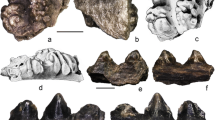Abstract
Based on a superbly preserved skeleton, a new anuran taxon has been named and described from the Yixian Formation (Upper Jurassic/Lower Cretaceous), Liaoning Province, northeastern China. This discovery documents the first discoglossid fossil from China, the earliest record of the group in Asia, and the only second Mesozoic discoglossid known from fully articulated material in the world. The family Discoglossidae is widely perceived as a primitive anuran group, but has no definite fossils found in collaboration with their recent distribution in Asia. The new diery from Liaoning extends the temporal range of the group in Asia back at least 120 million years, and provides valuable fossil material for study of anatomical details of early discoglossids, as well as of historical distribution of this primitive anuran group.
Similar content being viewed by others
References
Hou Lianhai, Zhou Zhonghe, Martin, L. D.et al., A beaked bid from the Jurassic of China,Nature, 1995, 377: 616.
Ji Qiang, Currie, P. J., Norell, M. A.et al., Two feathered dinosaurs fmm northeastern China,Nature, 1998, 393: 753.
Hu Yaoming, Wang Yuanqing, Luo Zhexiet al., A new symmetrodont mammal from China and its implications for mammalian evolution.Nature, 1997, 390: 137.
Ji Shu’an, New pterysaurs (Reptilia: Remsauria) from northeastern China and the geological age problem ofConfuciusornis, Journal of Vertebrate Paleontology, 1998, 18: 54 A.
Gao Keqin, Tang Zhilu, Wang Xiaolin, A long-necked diapsid reptile from the Upper Jurassic/Lower Cretaceous of Liaoning Rovince, northeastern China,Vertebrata PalAsiatica, 1999, 37(1): 1.
Spinar, Z.V., Tatarinov, L. P., A new genus and species of discoglossid frog from the Upper Cretaceous of the Gobi desert,Journal of Vertebrate Paleontogy, 1986, 6(2): 113.
Duellman, W. E., Trueb, L.,Biology of Amphibians, Baltimore and London: Johns Hopkins University Pres, 1986. 1–670.
Duellman, W. E., Amphibian species of the world: Additions and corrections,University of Kansaa Museum of Natural History Spccial Publication, 1993, 21: 1.
Shubin, N. H., Jenkins, Jr F. A., An Early Jurassic jumping frog,Noture, 1995, 377: 49.
Jenkins, Jr. F. A., Shubin, N. H.,Prosalirus bitis and the anuran caudopelvic mechanism,Journal of Vertebrate Paleontology, 1998, 18(3): 495.
Rocek, Z., Taxonomy and distribution of Tertiary discoglossid (Anura) of the genusLatonia v. Meyer, 1843,Geobios, 1994, 27(6): 717.
Trueb, L., Bones, frogs, and evolution,Evolutionary Biology of the Anurans: Contemporary Research on Major Problems (ed. Vial, J. L.). Columbia: University of Missouri Res, 1973, 65–132.
Trueb, L., Patterns of cranial diversity among the Lissamphibia,The Skull. Volume 2:Patterns of Structural and Systematic Diversity (eds. Hanken, J., Hall, B. K.), Chicago: University of Chicago h, 1993, 255–343.
Fabrezi, M., El cprpo de los anuros,Alytes, 1992, 10: 1.
Estes, R., Reig, O.A., The early fossil record of frogs: a review of the evidence,Evolutionary Biology of the Anurans:Contemporay Research on Major Problem (ed. Vial, J. L.), Columbia: University of Missouri h. 1973. 11–63.
Evans, S. E., Milner, A. R., Musset, F., A discoglossid frog (Amphibia: Anura) from the Middle Jurassic of England,Palaeontology, 1990, 33: 299.
Sanchiz, B., Salientia,Handbuch der Palatoherpetolgie (ed. Wellnhofer, P.), Teil 4, Munchen: Verlag Dr. Friedrich Pfeil. 1998. 1–275.
Hecht, M. K., The morphology of Eodiscoglossus, a complete Jurassic frog,American Museum Novitates, 1970, 2424: 1.
Vergnaud-Grazzini, C., Wenz, S., Len discoglossidés du Jurassique supérieur du Montsech (Province de Lérida, Espagne).Annales de Paléontologie (Vertebés), 1975, 61(1): 19.
Evene, S. E., McGowan, G., Milner, A. R.et al., Amphibians. In: II International Symposium on Lithographic Limestones,Field Trip Guide Book, 1995, 51–53.
Evans, S. E., Milner, A. R., Frogs and salamanders from the Upper Jurassic Morrison Formation (Quarry Nine. Como Bluff) of North America,Journal of Vertebrate Paleontology. 1993, 13(1): 24.
Swisher, C. C., Wang Yuanqing, Wang Xiaolinet al.,40Ar/39 Ar dating of the Lower Yixian Fm, Liaoning Province, northeastern China,Chinese Science Bulletin, 1998, 43 (Supp.): 125.
Ji Shu’an. Ji Qiang, The first Mesozoic fossil frog from China (Amphibia: Anura),Chinese Geology (in Chinese), 1998, 250: 39.
Author information
Authors and Affiliations
About this article
Cite this article
Wang, Y., Gao, K. Earliest Asian discoglossid frog from western Liaoning. Chin. Sci. Bull. 44, 636–642 (1999). https://doi.org/10.1007/BF03182726
Received:
Issue Date:
DOI: https://doi.org/10.1007/BF03182726




